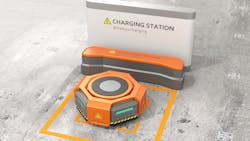How Autonomous, Wireless Charging is Ushering in Industry 4.0
Investments in advanced mobile robotics are helping industrial settings to remain competitive in today’s markets, empowering them to meet the demand for customization and rapid delivery without increased labor costs. However, in order to realize the full value of robotics investments, the industry is looking to wireless charging to keep autonomous mobile devices running 24/7.
Wireless charging systems use magnetic fields to transfer energy from a charging source pad installed on the factory floor to a receiving pad installed on the mobile robot. Modern wireless charging systems based on the principle of magnetic resonance have been proven to be safe, maintenance-free, highly efficient, and can charge just as quickly as a conventional wired charger. The technical advantage of wireless charging is that there is no mechanical or electrical contact needed between the charging source and the robot. This leads to significant benefits and cost savings.
By replacing labor-intensive and failure-prone plug-in charging and battery replacement processes with autonomous wireless charging systems, industrial settings can fully realize the benefits of their investments in advanced mobile robotics. These are immediate and far-reaching and include:
Enhanced Productivity, Vehicle Availability, and Safety
The conventional process for recharging mobile robotics, AGVs, and forklift trucks is to take the vehicle out of service to be recharged. For factories and warehouses that operate 24/7 with no “off-shift”, this means that the fleet of vehicles must be larger than necessary for moving goods, as many vehicles will be out of service and charging at any given time. Furthermore, plugging in and unplugging the vehicles from a charger is labor-intensive. Both factors increase the total cost of ownership (TCO) of the mobile fleet and run counter to the 24/7 “lights out” automation that Industry 4.0 demands. In some cases, automatic docking stations have been developed to enable the vehicle to “plug itself in”, via a specially designed electrical connector. Such docking stations require frequent maintenance, as repeated docking and undocking maneuvers wear out the electrical connectors and can become a serious safety hazard. The catastrophic fire at the Ocado automated grocery warehouse in the UK in 2019 was caused by faulty connectors in such a docking station for robot recharging. Such a catastrophe could have been prevented by using non-contact wireless charging technology instead of mechanical connections.
Automatic wireless charging can improve mobile robotic system productivity, availability, and safety. Mobile robots equipped with modern wireless charging technology based on magnetic resonance can be charged by multiple charging pads distributed throughout the facility, enabling what is called opportunity charging or power snacking. For example, at a station where a robot loads or unloads its cargo, or waits in queue, it can be charged while it is idle. Modern wireless charging solutions do not require precise positioning of the robot, so charging can be started as soon the robot is in reasonable proximity to the charging pad. This ability to charge on-the-go, versus having to be taken out of service for several hours of charging, enables operators to minimize the number of robots needed to serve the facility. It also reduces maintenance costs by eliminating the need to service and replace connectors and cables that wear out. Frequent opportunity charging will keep the battery from being fully depleted, thus extending the service life of the battery pack.
DAIHEN Corporation, a global supplier of power electronics and industrial equipment, is one company that has produced and deployed thousands of such wireless charging systems for mobile robotics. DAIHEN developed a family of wireless charging systems called D-Broad that can be retrofit to existing machinery and incorporated into new robotic devices. Its systems have been deployed in a wide range of industrial and logistics facilities globally and can deliver up to 4 kW of charging power. JJPlus is another company that develops low-medium power wireless charging systems capable of charging at up to 400 watts. Such systems are targeted to make mobile robotics systems used for surveillance, customer support, and other light industrial, retail, and hospitality applications. The wireless charging systems offered by DAIHEN and JJPlus use patented magnetic resonance technology, enabling them to offer the efficiency and positioning freedom needed for fully automated non-contact charging applications.
Impact of COVID-19
The COVID-19 pandemic has created new opportunities and challenges for manufacturing and logistics. Demand for home delivery of a wide variety of consumer needs has skyrocketed, and e-commerce businesses are scrambling to fill this demand. Automated delivery of products by autonomous neighborhood vehicles and drones is being developed and deployed. Automated warehousing and fulfillment are being deployed globally. These factors are increasing the demand for autonomous mobile robotic systems, all of which need reliable and safe autonomous charging. Furthermore, industrial processes that are today manual, literally requiring human hands-on “touch”, are seen to be vectors for the spread of the virus amongst essential workers. The nature of work is changing before our eyes during this unprecedented situation.
Companies that embrace new technologies for automation, such as mobile robotics with autonomous wireless charging, will be well prepared to meet the demands of the marketplace while bolstering the health, safety, and productivity of their workforce.
